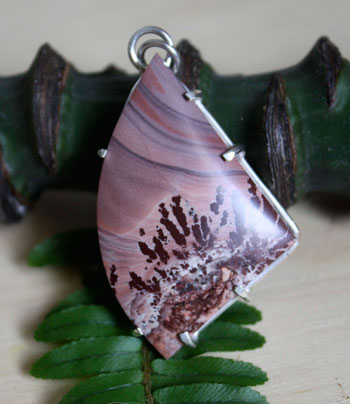- Jewelry
- Inspiration
- Good Deals
- Paintings
- About
- Contact
JEWELRY
- Anklet
- Bracelets
- Brooches
- Cufflinks
- Earrings
- Pendants & Necklaces
- Rings
- Draw your jewelry
- GOOD DEALS
- How to clean your jewel
- Metal we used
INSPIRATION
- Our imagination
- Birthstones
- Druids and druidesses
- Flower meanings
- History, archeology jewelry
- Japanese symbols
- Lithotherapy and stone choice
- Illumination jewelry
- Maya calendar jewelry
- Stone color symbolism
- Stones Catalogue
- Searches a theme on the site
ABOUT
Rhyolite: history, healing properties and lithotherapy

Rhyolite properties

Rhyolite, a volcanic rock with a variety of colors, derives its name from the combination of the Greek words "Rhein," meaning "to flow," and "lithos," which translates to "stone." This name was given by the German geologist Ferdinand Von Richthofen, who contributed to the study and classification of volcanic rocks.
Rhyolite, a volcanic rock belonging to the feldspar family, is formed from the solidification of magma. It is characterized by the presence of quartz, feldspar, and amphibole crystals, giving this stone a unique texture and remarkable properties.
The silica-rich magma, characteristic of rhyolite, can give rise to vitreous rocks such as obsidian when it cools rapidly. However, slower cooling promotes the formation of crystals, creating unique patterns and textures that contribute to the beauty and diversity of rhyolite.
Rhyolite lava flows offer a remarkable diversity of colors and shapes. Dominant hues such as green, yellow, caramel, orange, ochre, and brown blend into fascinating patterns.
These volcanic flows shape stones with varied aspects, ranging from bands to bubbles to crystal layers, producing specimens as astonishing as tropical forest jasper or Apache rhyolite. When the cooling process is very slow, porous rocks filled with air bubbles, like pumice, can form, adding another dimension to the geological richness of rhyolite.
Rhyolite, history, stories, legends and beliefs
The history and traditional use of rhyolite are still largely unknown, although it is known that this stone has been used since ancient times. Its use in ancient cultures remains a subject of research and debate among archaeologists and historians.
Healing properties and benefits of the rhyolite
Rhyolite, a stone with fascinating properties,
- Natural body resistance: Rhyolite is reputed to increase the body’s natural resistance.
- Immune system stimulation: It is also known to stimulate the immune system.
- Kidney and liver health: Rhyolite is associated with benefits for kidney and liver health, helping to reduce kidney stones and promoting their cleansing.
- Skin problems: It is also reputed to help fight skin problems, especially those of viral origin.
- Slowing down aging: Rhyolite is associated with virtues in the fight against aging.
- Vitamin absorption: Finally, it is reputed to improve vitamin absorption, thus contributing to overall better health.
 Please note that all healing properties presented for gemstones are gathered from various sources. This information is provided as a service and is not intended to treat medical conditions. It is recommended to consult a healthcare professional for serious medical issues and not to rely solely on gemstones as a treatment.
Please note that all healing properties presented for gemstones are gathered from various sources. This information is provided as a service and is not intended to treat medical conditions. It is recommended to consult a healthcare professional for serious medical issues and not to rely solely on gemstones as a treatment.
Rhyolite jewelry samples
To learn more about litotherapy, we recommend you the following books:





